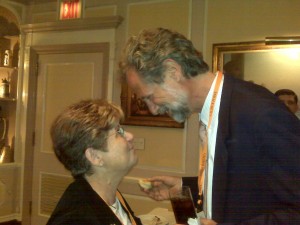I’m writing this as Ron and I are in New England visiting my family and both childhood and university friends. One of our visits is to North Haven Island, off the coast of Maine and only accessible by Ferry (assuming the seas aren’t running too high). I’m told we’ll have at least limited cellular service, and our B&B advertises wifi, so I’m sure I’ll be able to finish and post this wherever I am.
But it’s not all lazy, hazy, crazy days of summer at Bloom & Wallace (you might play the music while reading the rest of this post). A quick look at my calendar and todo list are enough to frighten anyone, but that’s what comes of trying to pack two years of living — professionally and personally — into every calendar year. The good news is that 2014 is going to be different.
Meanwhile, 2013 is already a record breaker. It does my heart good to see so many major HRM enterprise software vendors and outsourcing providers hot on the trail of bringing correct object models and Blooming architecture to their increasingly true SaaS platforms. Yes, metadata frameworks, proper multi-tenant architectures with inheritance and systemic effective-dating, and position-based and KSAOC-centric object models are just some of what’s taking root in our collective garden — although there continue to be far more weeds than I would like. And all of this will be a topic for discussion and “killer” scenario vendor demos in Vegas. These positive developments are just one of the reasons that I thought 2013 was the right year to make some big changes at Bloom & Wallace.
If you read my post about big changes at Bloom & Wallace, then you know that 2013 is the last year I’ll be doing my very favorite “Ask the Expert” session at HR Tech (unless Steve Boese, our new conference co-chair, let’s me call it “Ask the Expert and a few of her favorite thought leaders who’ve come along to back her up”). The timing couldn’t be better for my topic: “Should you spend one more dime on legacy vendors/products/data or process designs?” It’s absolutely time to revisit not just the terrific innovation going on at the periphery of our HRM processes and systems but also at the very core of those processes and systems — our foundational HRMS with integrated talent management platform along with their data and process designs. For many of us, it’s well past time that we took a fresh look at our business needs as they are now, with social, global, mobile, analytics, and so much more demanding our attention, and created an HRM delivery systems strategy for the future. So do bring your questions and your snark-o-meter to my session. Along with the business model changes at Bloom & Wallace has come a noticeable reduction in my never substantial inhibitions, so I’m sure we’ll bring down the house.
There are a ton of other great sessions scheduled (you can download the entire program here), and the exhibit hall will be crammed. I’m making as much time available as possible to attend those sessions and, as I do every year, to try and do at least a flyby at every vendor booth — although Bill tells me that, with more exhibitors than ever, there’s no way, even with The Wallace’s help, I’m going to get to every booth. I won’t even try to summarize the program because our impresario, Bill Kutik, writes the best marketing copy ever for this show, and you can find all of it at the conference Web site right here. But hot topics for me this year are all things analytics, Lexy Martin’s survey results, and getting real about enabling HRM processes with collaboration (aka social tech), and robotics — yes, robotics. Just as we’ve wiped out a ton of jobs with information technology, many more will be eliminated via the increased use of robotics, and all those robots must be spec’d (requisitioned?), acquired, onboarded, deployed, upgraded (developed?), and eventually retired/replaced/terminated.
